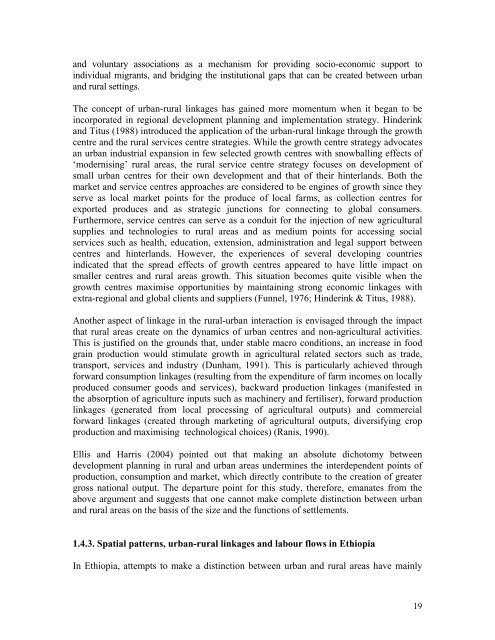Migration and Rural-Urban Linkages in Ethiopia
Migration and Rural-Urban Linkages in Ethiopia - Ethiopian Review
Migration and Rural-Urban Linkages in Ethiopia - Ethiopian Review
Create successful ePaper yourself
Turn your PDF publications into a flip-book with our unique Google optimized e-Paper software.
<strong>and</strong> voluntary associations as a mechanism for provid<strong>in</strong>g socio-economic support to<strong>in</strong>dividual migrants, <strong>and</strong> bridg<strong>in</strong>g the <strong>in</strong>stitutional gaps that can be created between urban<strong>and</strong> rural sett<strong>in</strong>gs.The concept of urban-rural l<strong>in</strong>kages has ga<strong>in</strong>ed more momentum when it began to be<strong>in</strong>corporated <strong>in</strong> regional development plann<strong>in</strong>g <strong>and</strong> implementation strategy. H<strong>in</strong>der<strong>in</strong>k<strong>and</strong> Titus (1988) <strong>in</strong>troduced the application of the urban-rural l<strong>in</strong>kage through the growthcentre <strong>and</strong> the rural services centre strategies. While the growth centre strategy advocatesan urban <strong>in</strong>dustrial expansion <strong>in</strong> few selected growth centres with snowball<strong>in</strong>g effects of‘modernis<strong>in</strong>g’ rural areas, the rural service centre strategy focuses on development ofsmall urban centres for their own development <strong>and</strong> that of their h<strong>in</strong>terl<strong>and</strong>s. Both themarket <strong>and</strong> service centres approaches are considered to be eng<strong>in</strong>es of growth s<strong>in</strong>ce theyserve as local market po<strong>in</strong>ts for the produce of local farms, as collection centres forexported produces <strong>and</strong> as strategic junctions for connect<strong>in</strong>g to global consumers.Furthermore, service centres can serve as a conduit for the <strong>in</strong>jection of new agriculturalsupplies <strong>and</strong> technologies to rural areas <strong>and</strong> as medium po<strong>in</strong>ts for access<strong>in</strong>g socialservices such as health, education, extension, adm<strong>in</strong>istration <strong>and</strong> legal support betweencentres <strong>and</strong> h<strong>in</strong>terl<strong>and</strong>s. However, the experiences of several develop<strong>in</strong>g countries<strong>in</strong>dicated that the spread effects of growth centres appeared to have little impact onsmaller centres <strong>and</strong> rural areas growth. This situation becomes quite visible when thegrowth centres maximise opportunities by ma<strong>in</strong>ta<strong>in</strong><strong>in</strong>g strong economic l<strong>in</strong>kages withextra-regional <strong>and</strong> global clients <strong>and</strong> suppliers (Funnel, 1976; H<strong>in</strong>der<strong>in</strong>k & Titus, 1988).Another aspect of l<strong>in</strong>kage <strong>in</strong> the rural-urban <strong>in</strong>teraction is envisaged through the impactthat rural areas create on the dynamics of urban centres <strong>and</strong> non-agricultural activities.This is justified on the grounds that, under stable macro conditions, an <strong>in</strong>crease <strong>in</strong> foodgra<strong>in</strong> production would stimulate growth <strong>in</strong> agricultural related sectors such as trade,transport, services <strong>and</strong> <strong>in</strong>dustry (Dunham, 1991). This is particularly achieved throughforward consumption l<strong>in</strong>kages (result<strong>in</strong>g from the expenditure of farm <strong>in</strong>comes on locallyproduced consumer goods <strong>and</strong> services), backward production l<strong>in</strong>kages (manifested <strong>in</strong>the absorption of agriculture <strong>in</strong>puts such as mach<strong>in</strong>ery <strong>and</strong> fertiliser), forward productionl<strong>in</strong>kages (generated from local process<strong>in</strong>g of agricultural outputs) <strong>and</strong> commercialforward l<strong>in</strong>kages (created through market<strong>in</strong>g of agricultural outputs, diversify<strong>in</strong>g cropproduction <strong>and</strong> maximis<strong>in</strong>g technological choices) (Ranis, 1990).Ellis <strong>and</strong> Harris (2004) po<strong>in</strong>ted out that mak<strong>in</strong>g an absolute dichotomy betweendevelopment plann<strong>in</strong>g <strong>in</strong> rural <strong>and</strong> urban areas underm<strong>in</strong>es the <strong>in</strong>terdependent po<strong>in</strong>ts ofproduction, consumption <strong>and</strong> market, which directly contribute to the creation of greatergross national output. The departure po<strong>in</strong>t for this study, therefore, emanates from theabove argument <strong>and</strong> suggests that one cannot make complete dist<strong>in</strong>ction between urban<strong>and</strong> rural areas on the basis of the size <strong>and</strong> the functions of settlements.1.4.3. Spatial patterns, urban-rural l<strong>in</strong>kages <strong>and</strong> labour flows <strong>in</strong> <strong>Ethiopia</strong>In <strong>Ethiopia</strong>, attempts to make a dist<strong>in</strong>ction between urban <strong>and</strong> rural areas have ma<strong>in</strong>ly19




![to read the full report [pdf, Amharic] - Ethiopian Review](https://img.yumpu.com/52737829/1/190x245/to-read-the-full-report-pdf-amharic-ethiopian-review.jpg?quality=85)











